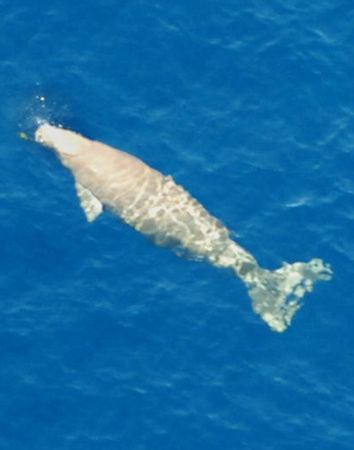ODB recorded call from heretofore unidentified dugong in waters surrounding Henoko in August

A dugong swimming calmly through the waters off the coast of Kayo, Nago City in March 2008
October 17, 2017 Ryukyu Shimpo
By Chie Tome
In order to study the impacts of replacement facility construction in Henoko, Nago City for Futenma Air Station (currently located in Ginowan City), the Ministry of Defense’s Okinawa Defense Bureau (ODB) is conducting a dugong habitat investigation in the surrounding waters.
Due to a dugong’s call recorded on August 28 in Ada, Kunigami Village, it came to light that dugong specimen C, which has not been spotted since June 2015, may still be out there.
The ODB announcement of this finding was recorded in the minutes from the October 10 meeting of the Environmental Oversight Committee in its 9th session (which began on September 27).
In order to identify the dugongs’ habitats and various behavioral tendencies, the ODB is continuing to monitor the dugongs using aircraft and underwater audio recording equipment.
Each specimen cannot be identified based on audio alone, but by observing other dugongs within the same time frame, circumstantially it appears possible that there are only three dugongs in Okinawa, one of them being specimen C.
According to the Environmental Oversight Committee’s minutes, around 10:00 a.m. on August 28 some recording equipment underwater in Ada captured a sound thought to be a dugong call.
However, since a surveying helicopter observed specimen B in the waters of Kouri at 9:53 a.m. the same day, the ODB has surmised that the dugong call captured was not from specimen B.
Based on recordings up to this point, the range of specimen A’s habitat is generally limited to the water area of Kayo.
Therefore, committee members have indicated the recording in Ada is likely the call of specimen C.
The ODB is taking another angle due to difficulties in identifying specimens based on their calls: “This may be specimen C, but we are not ruling out the possibility that it was specimen A.”
What seem to be dugong calls were recorded in Ada’s waters in the afternoon on August 29 and 30, as well.
Director Mariko Abe of the Nature Conservation Society of Japan said, “If specimen C is confirmed I will be delighted, but still the objective of the underwater audio recording equipment is unclear.”
She mentioned that above collecting weak call recordings to identify specimens, “It is essential to take effective conservation measures.”
(English translation by T&CT and Erin Jones)
Previous Article:Okinawa Prefectural Assembly passes three resolutions in protest of the U.S. military helicopter fire in Takae, demand ban on helipad use
Next Article:Kachaashi dance event held in Ginowan
[Similar Articles]
- One of only three Okinawa dugong specimens found dead, whereabouts of other two unknown
- Two missing dugongs may substantiate OPG claim that Henoko construction harms environment
- Henoko Environmental Oversight Committee specialist says Okinawa dugong is “highly likely extinct”; large-scale survey needed
- Dugong survey fails to confirm that dugong still inhabit ocean around Okinawa Island
- MOE investigates sightings of two dugong near Hateruma Island
 Webcam(Kokusai Street)
Webcam(Kokusai Street)


